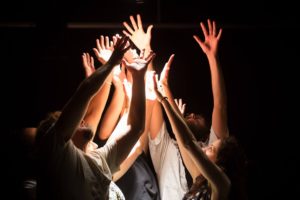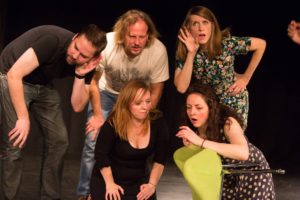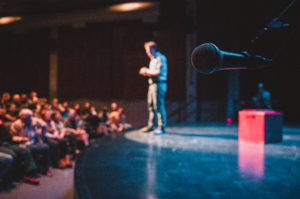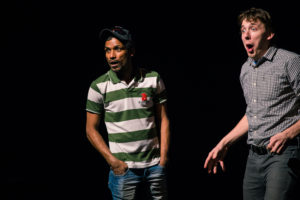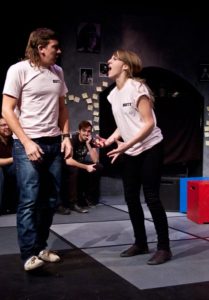EPIC FAIL

In March 2019, I organized a dialogue for artists. While it wasn’t the first dialogue I had ever convened, it felt significant because it was the first one I had hosted after having done any research on what a dialogue is and how to convene one. 😂
Don’t get me wrong. Other meetings I had organized in the past had been successful by some standard, mostly because I was so determined to have a conversation about something important, or bring a group of people together, that it didn’t seem to matter to me how I did it, just that I did.
Taking classes at SFU over the last couple years, in the Dialogue and Civic Engagement Certificate, has given me some deeper perspective around the idea of bringing people together for a conversation. While having the initial idea combined with undying optimism, is a good start, it is not nearly enough to deal with complex issues on the fly. I think back on some of the conversations I had convened in the past, and realize now, that I was in over my head. The only thing keeping things on track were the social norms that people brought into the room, and my gut, which was the only tool I had to navigate some truly ugly moments.
The courses I’ve taken, have constantly challenged me to think about more planning, and always digging deeper. Looking for underlying assumptions, and searching for more powerful questions. For my final project in the Dialogue and Civic Engagement Certifcate, I decided to convene a dialogue of my own titled “EPIC FAIL: Fear and Failure in the Creative Process.”
My chosen method for the dialogue was to host a World Café. You can learn more about it here. In preparation for my event, I took part in an online World Café; a monthly World Café session that anyone can join. I found it to be a solid learning opportunity, as well as a very cool experience, and I would highly encourage anyone give it a try. Through this online dialogue, I got to have in-depth conversations with people from around the globe (South Africa, Australia, Burkina Faso, The Netherlands), about topics that matter.
In the spring, after some deep thought, and several meetings with my project advisor, it was finally time to host the dialogue I had been planning for months. I booked a room at the Roundhouse Community Centre, and got pretty excited about office supplies. My event was specifically aimed at artists, and 19 attended. There were dancers, a textile artist, a painter, filmmakers, comedians, a graphic designer, actors, theatrical improvisors, and musicians.

My goals for the dialogue were to foster:
- A deeper collective understanding of fear and failure
- Empathy between artists
- Stronger relationships between Vancouver artists
We began the Dialogue with introductions and a group activity that was fun and energizing, and also highlighted the theme of failure. The leading questions we explored throughout the three hour event:
- Share a story about a time when you experienced failure (or fear of failure) in your artistic practise?
- What does failure or fear of failure feel like?
- What are you learning or noticing about failure?
- What can support us in our failures? How do we know when to quit?

One wonderful surprise was that when the topic of the dialogue is fear and failure, it actually makes it easy to incorporate those ideas into hosting. I started the day by talking about how nervous I was coming to the space, and how I was afraid no one would show up. Many people nodded, some laughed, and my comments seemed to acknowledge the nerves in the room. One learning I took away from convening this dialogue is: once you acknowledge that fear is present, and failure is possible, it seems to take the power away from those ideas.
By the closing circle at the end of the day, several people expressed that they had had epiphanies throughout the day. People talked about the relationship between expectations and failure. We talked about when your failure affects others. Accepting that risks lead to failure, and there is learning to be done in both the failure itself and how we react to it. We talked about how capitalism sets the tone of competition, and if everything is a competition, there are winners and losers – succeeders and failers. We talked about the shame of failure. We talked about death, and the deep motivating fear of not having a story to tell, not having an impactful life.
A colleague of mine, following the dialogue, sent me this Ted Talk by Jia Jiang, talking about 100 Days of Rejection. His project is an absolutely whimsical reminder of what can happen when we put fear aside and ask for what we want. His talk suggests that what can support us in our failure is a curiosity about it – asking why, acknowledging doubts, being persistent.
Now that I’ve finished the Dialogue & Civic Engagement program, I’ve had more time to reflect on some of the concepts and tools I have taken from the courses. I’ve noticed small changes in the way I listen, the way I allow silence to play more of a role in conversations, and the way I ask questions. I also feel much better equipped to organize tough conversations, to allow people to engage honestly in what is important to them. But most of all, I’ve spent the summer trying to get more curious about my failures (past, present, and future).

